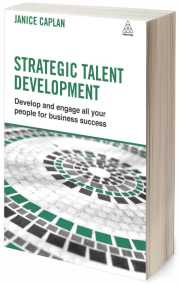Title: Strategic Talent Management
Authors: Janice Caplan
ISBN: 978-0749469368
Reviewer: David Evans, Burn Bridge Associates
Books on talent and people development are – for me – always likely to please, simply because of the importance of the subject. We should all be interested in personal development, shouldn’t we?!
“Practical and grounded in delivery.”
This book is therefore the latest in a large number that tackles this subject. In truth, although talent is very much at its heart – as you’d expect from the title! – I think this is really a useful guide around the topics of organisational development and the management of change. Given that, it is practical and grounded in delivery; in the pursuit of excellent HR practice; even if it does not particularly say anything new.
Like many contemporary business books, Caplan spends some time early on contextualising the work environment in which strategic talent development resides. The emergence from the economic downturn, the imperative of innovation and innovative thinking, the increasing speed of change and new ways of working brought about through globalisation and technology: all these factors – and more – challenge us to think differently about the way we run our business operations.
“Difficulty in finding and hiring the right people.”
The critical trend for the corporate world is, perhaps, the continuing shortage of skills in the workplace and the difficulty of finding and hiring the right people (the author quotes PwC’s 15th Global CEO Survey in support of this – p.110). A phenomenon first popularised in the mid 1990s remains: the nurturing, retention and fulfilment of talent. The journey that Caplan takes us on is one from the job-for-life era to the world of selection.
Its introduction rightly emphasises the tenet of ‘shared values, shared visions and shared understanding’ (p.6): this is not only the basis of the management thinking of our age; it also provides the cornerstone for the management of talented individuals in whom the organisation is encouraged to invest. The author introduces us to her model for strategic talent management, which provides the framework for the rest of the book: starting from the individual’s perspective, the model moves through from ‘future focus’, ‘self-managed succession’, ‘people databank’ and ‘shared management’ – a progression from the individual to the corporate.
“Identifying the boundaries within which individuals need to self-manage.”
The author also talks about the conditions in which talent can thrive, and this means having to identify the boundaries within which individuals need to self-manage. Thus in addition to a substantial section about values and ethics, there is a helpful discussion about the role that employee engagement plays and the need for leaders to establish the conditions in which talent can thrive via a coaching style and distributed leadership. In a chapter on organisational values, she highlights the importance of creating a ‘framework for employment’, wherein role-ambiguity is minimised and openness and sharing maximised – “one aim of your talent and engagement strategy is to join up your people processes and integrate them with business strategy so that your processes transmit consistent messages and influence consistent behaviour” (p36).
Not surprisingly, Caplan emphasises the point that self-improvement is largely our own responsibility and that corporate resources are there to support rather than drive individual progress. HR’s role is to support line management and provide the expertise to all so that resources can be given the best possible chance of adding value. A key emerging theme throughout the book is the rolling-back of the old command-and-control approach to management and the emergence of distributed responsibility. Indeed there are several points in the book where the author stresses the benefits of a human-capital based strategic planning process rather than the traditional market-driven or top-down approach to corporate planning. Another leitmotif is the need for managers to regard their people as human capital – a pool of assets – rather than simply as ‘inputs’.
“New expertise every few years.”
The middle of the book deals with learning and career management from the perspective of the employee, and Caplan launches this section with the bold statement that “the pace of change will be so rapid that people may have to acquire a new expertise every few years if they want to be part of the lucrative market for scarce talent” (p.83). If you believe this, then a facet of management surely has to be to ensure that the workplace becomes a learning environment, where experience is valued, captured and shared. Inherent in this is the shift from a focus on an individual’s role and on organisational needs, to an emphasis on the capabilities that will ensure long-term value.
Furthermore, organisations need to manage their systems, processes and data-capture mechanisms to support learning, personal development and the identification of development opportunities for individuals. Without these structures being in place, it is unlikely that resources will be appropriately organised. The later chapters deal, therefore, with the convergence of HR processes with talent management and human-asset deployment. Caplan also makes an interesting distinction between ‘nearby’ and ‘faraway’ management and what they can do to support talent development – the former being those managers with direct influence on talented people and the latter being distal (e.g. senior leaders) with indirect influence. It is useful to be reminded about the different roles, responsibilities and impact that management tiers can have on HR process.
This is a practical, useful and valuable book that, whilst not breaking new ground on the main topic, covers the subject in a well-informed and convincing way. It has some well-conceived frameworks and is altogether well presented. I am not convinced that it is necessary to feature the tools and techniques listed in the chapters about nearby and faraway management in such detail; nor do I feel that the early detailed pages on context and OD add commensurate value. However, it is a good read and would be a great book to pass to interested line managers with a keen interest in knowing more about talent management.
Reviewer’s rating: 3 out of 5










